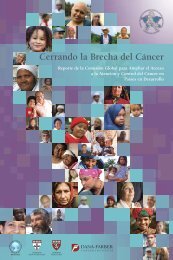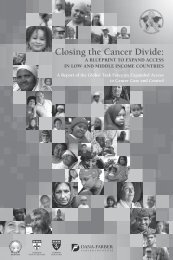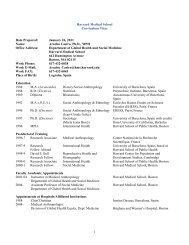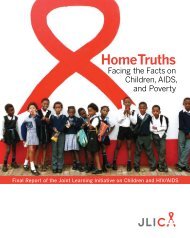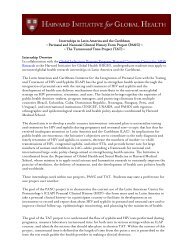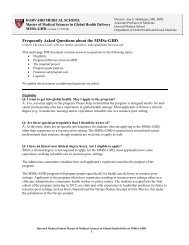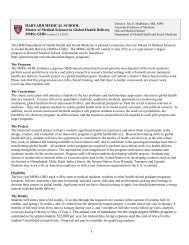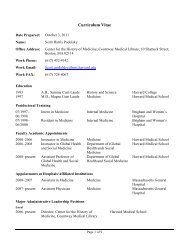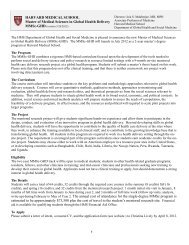Haiti Case Study - The Department of Global Health and Social ...
Haiti Case Study - The Department of Global Health and Social ...
Haiti Case Study - The Department of Global Health and Social ...
Create successful ePaper yourself
Turn your PDF publications into a flip-book with our unique Google optimized e-Paper software.
32. New technology <strong>of</strong>fers an opportunity to complement traditional epidemic tracking. A<br />
study team from the Karolinska Institutet found a way to monitor an infectious disease<br />
outbreak in real time by analysing the population's movement using cell phone tracking. 189<br />
<strong>The</strong>re is a trend towards widespread access to mobile phones, even in countries with poor<br />
sanitary <strong>and</strong> health conditions. 190 In <strong>Haiti</strong>, Digicel estimates that among the 10 million<br />
inhabitants over 5 million cell phones are in use. However, there are legal issues relating to<br />
the release <strong>of</strong> confidential cell phone tracking data. One <strong>of</strong> the first steps that an<br />
organization needs to take to access such data is to contact the phone regulator.<br />
Flowminder an organization set up by the authors <strong>of</strong> the Karolinska Institutet study, got<br />
approval from Groupe Spéciale Mobile Association (GSMA) 191 to be a single source, trusted<br />
<strong>and</strong> a known entity for carriers to send this type <strong>of</strong> information.<br />
33. Also, web based analysis <strong>of</strong> social media news such as Twitter feeds proved, in<br />
hindsight, to be useful in tracking the cholera epidemic faster than traditional sources. This<br />
new approach for epidemic surveillance could help responders in an important window <strong>of</strong><br />
opportunity to react very quickly to implement aggressive measures to stop the outbreak<br />
from spreading. A study published in Nature 192 describes how data collected through social<br />
media sites accurately tracked the <strong>Haiti</strong>'s cholera outbreak faster <strong>and</strong> more cost effectively<br />
than traditional surveillance methods. By measuring the volume <strong>of</strong> informal news media<br />
generated during the first 100 days <strong>of</strong> the outbreak <strong>and</strong> looking at the number <strong>of</strong> "cholera"<br />
posts on Twitter using an automated surveillance platform called “<strong>Health</strong>Map”, researchers<br />
found that as the <strong>of</strong>ficial number <strong>of</strong> cases increased <strong>and</strong> decreased, so did the volume <strong>of</strong><br />
informal media reports about cholera. This observed correlation means such reports could<br />
be used to get earlier estimates <strong>of</strong> a disease outbreak <strong>and</strong> help plan a response sooner.<br />
Other advantages include finer temporal <strong>and</strong> spatial resolution, <strong>and</strong> the study says informal<br />
media could be used to study other disease outbreaks around the world.<br />
Preventing Spread<br />
34. From an international responder’s perspective, there are several measures that need to<br />
be taken to prevent the spread <strong>of</strong> a waterborne infectious disease, the first <strong>of</strong> which is to stop<br />
any imported disease from leaving international compounds. <strong>The</strong> expert panel suggested<br />
United Nations installations worldwide should treat faecal waste using on-site systems that<br />
inactivate pathogens before disposal. <strong>The</strong>se systems should be operated <strong>and</strong> maintained by<br />
trained, qualified United Nations staff or by local providers with adequate United Nations<br />
oversight. 193<br />
35. Once a waterborne infectious disease has reached the waterways, the main way to<br />
stop its spread is to ensure good sanitation <strong>and</strong> access to safe drinking water. In the shortterm,<br />
IDP camps in <strong>Haiti</strong> were notable for their low levels <strong>of</strong> reported cholera due to the<br />
access to purified water <strong>and</strong> waste treatment they provided to the population. But, as<br />
recently mentioned by the UN Humanitarian Coordinator in <strong>Haiti</strong>, those camps which had<br />
benefited from chlorinated water provided by relief organizations might face issues as some<br />
<strong>of</strong> the services cease because <strong>of</strong> shortage <strong>of</strong> funding. 194 It was noted that, if servicing <strong>of</strong><br />
latrines in IDP camps were stopped for any reason (e.g. due to lack <strong>of</strong> funding), poor<br />
sanitation conditions among the camps could lead to rapid increase <strong>of</strong> the disease<br />
transmission. 195 Medical treatment facilities are a further concern where waste <strong>and</strong> bodies <strong>of</strong><br />
infected people must be dealt with appropriately. Participants <strong>of</strong> the health cluster discussed<br />
whether the military could be helpful in supporting the local authorities <strong>and</strong> funeral services in<br />
transporting contaminated bodies to the burial place.<br />
36. Another short-term measure is "point <strong>of</strong> source" purification which while certainly an<br />
important part <strong>of</strong> the epidemic response in <strong>Haiti</strong>, was less effective than it could have been<br />
because <strong>of</strong> the challenges inherent in coordinating the distribution <strong>of</strong> kits <strong>and</strong> training endusers<br />
in their proper use.<br />
37. In general, the UNEP strongly suggests investing in basic access to a safe water<br />
sources <strong>and</strong> sanitation would have the largest impact on health, in particular averting<br />
C-6



